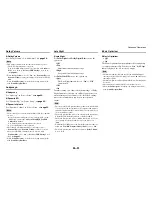
Advanced Operations
En-60
■
Left, Front Wide Left, Front High Left, Center,
Front High Right, Front Wide Right, Right,
Surround Right, Surround Back Right, Surround
Back Left, Surround Left, Subwoofer
`
Specify the distance from each speaker to your
listening position.
Note
• Speakers that you set to “
No
” or “
None
” in “Speaker
Configuration” cannot be selected (
➔
page 58
).
• When the “
Powered Zone 2
” setting is set to “
Yes
” and Zone 2
is turned on, the surround back and front high speakers cannot be
used.
• When the “
Powered Zone 3
” setting is set to “
Yes
” and Zone 3
is turned on, the surround and surround back speakers cannot be
used.
Level Calibration
Here you can adjust the level of each speaker with the
built-in test tone so that the volume of each speaker is the
same at the listening position.
■
Left, Front Wide Left, Front High Left, Center
*1
,
Front High Right, Front Wide Right, Right,
Surround Right, Surround Back Right, Surround
Back Left, Surround Left
`
–12.0dB
to
0.0dB
to
+12.0dB
in 0.5 dB steps.
■
Subwoofer
*1
`
–15.0dB
to
0.0dB
to
+12.0dB
in 0.5 dB steps.
Note
• These settings cannot be calibrated when the AV receiver is
muted.
• Speakers that you set to “
No
” or “
None
” in “Speaker
Configuration” cannot be selected (
➔
page 58
).
• When the “
Powered Zone 2
” setting is set to “
Yes
” and Zone 2
is turned on, the surround back and front high speakers cannot be
used.
• When the “
Powered Zone 3
” setting is set to “
Yes
” and Zone 3
is turned on, the surround and surround back speakers cannot be
used.
• The test tone is output at the standard level for THX, which is
0 dB (absolute volume setting 82). If you normally listen at
volume settings below this, be careful because the test tone will
be much louder.
*1
For the center speaker and subwoofer, the level settings made
by using the Quick Setup are saved in this menu (
➔
page 50
).
Tip
• If you’re using a handheld sound level meter, adjust the level of
each speaker so that it reads 75 dB SPL at the listening position,
measured with C-weighting and slow reading.
Equalizer Settings
With the Equalizer settings, you can adjust the tone of
speakers individually with a 15-band equalizer. The
volume of each speaker can be set (
➔
page 60
).
■
Manual Equalizer
`
On
:
You can adjust the equalizer for each speaker
manually. Continue with the following procedure:
`
Off
:
Tone off, response flat.
Note
• When the Direct listening mode is selected, the equalizer settings
have no effect.
• If “
Audyssey
” is enabled, it prevails over this setting
(
➔
page 66
).
This setting is set automatically by
Audyssey MultEQ
®
XT32 Room Correction and
Speaker Setup (
➔
page 35
).
1
Press
w
to select “Channel”, and then use
e
/
r
to
select a speaker.
2
Use
q
/
w
to select a frequency, and then use the
e
/
r
to adjust the level at that frequency.
The volume at each frequency can be adjusted from
–6dB
to
0dB
to
+6dB
in 1 dB steps.
Tip
• You can select: “
25Hz
”, “
40Hz
”, “
63Hz
”, “
100Hz
”,
“
160Hz
”, “
250Hz
”, “
400Hz
”, “
630Hz
”, “
1000Hz
”,
“
1600Hz
”, “
2500Hz
”, “
4000Hz
”, “
6300Hz
”, “
10000Hz
”
or “
16000Hz
”. And for the subwoofer, “
25Hz
”, “
40Hz
”,
“
63Hz
”, “
100Hz
”, or “
160Hz
”.
• Low frequencies (e.g., 25Hz) affect bass sounds; high
frequencies (e.g., 16000Hz) affect treble sounds.
3
Use
q
to select “Channel”, and then use
e
/
r
to
select another speaker.
Repeat steps 1 and 2 for each speaker.
You cannot select speakers that you set to “
No
” or
“
None
” in the “Speaker Configuration”
(
➔
page 58
).






























